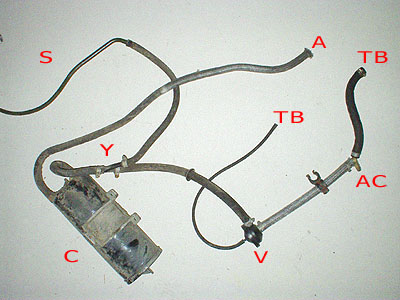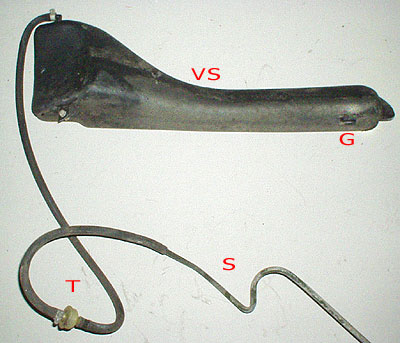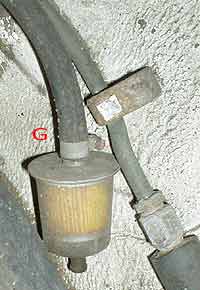Gas Vent System
#1
Inventor
Rennlist Member
Rennlist Member
Thread Starter
Kinda boring but...
'Mark Schwager' asked in a previous post: "I have replaced all the other hoses except the ones to the carbon canister. In looking at the vacuum diagram, it appears that there is a vacuum set up that draws excess fumes from the tank through the canister and into the air filter. What are the symptoms of a leak on the canister side? It is not at all clear how these interact with the rest of the vacuum system. Do canisters wear out? How would you know? The shop manual say exactly squat on all this.".
After taking the pics and writing the copy, I reckoned this would be better as a separate archival post.
Pictures from my US '81.
The main problems are the hoses get brittle and/or the plastic Y connectors can break, letting in unregulated/unfiltered air. I don't know if the carbon cannister can wear out.
The control-valve (V) regulates the purging of the vapor sytem during part-throttle cruising.
Note that the small vacuum hose from V, marked TB, actually goes through a temperature switch (located under the heater hose connection) which is connected to ported vacuum, T-ed off the distributor vacuum advance line. (In my '81 glovebox manual vacuum-diagram, the thermo-valve is not shown.)
Unless the A/C is running, the vapors go to the atmospheric side of the throttle plate, so the vapors are drawn in by a venturi effect. The amount of vacuum is inverse of the vacuum in the plenum. Put another way, the air rushing in when the throttle plate is open creates a vacuum in the vapor line (same as the vacuum advance). This is unmetered air bypassing the AFM (which leans out the AFM signal). When the A/C is running, the speedup valve takes air from the vapor system and dumps it into the front of the plenum directly.
Front passenger side wheel well/engine compartment:

A - airbox connection
AC - A/C speedup valve/plenum connection
C - charcoal cannister
S - steel underbody line
TB - throttle body connection
Y - Y connector
V - valve
Rear passenger side wheel well:

G - gas tank connection
S - steel underbody line
T - tipover safety valve
VS - vapor separator
---------------------------------------------------------
OK, class is over, here's what I did a while back...
All the above replaced with a 3/8" Fram gas filter and some vacuum caps*.
Rear passenger side wheel well:

G - gas tank connection
*Kids, get your parents' permission!
~thread~start~
'Mark Schwager' asked in a previous post: "I have replaced all the other hoses except the ones to the carbon canister. In looking at the vacuum diagram, it appears that there is a vacuum set up that draws excess fumes from the tank through the canister and into the air filter. What are the symptoms of a leak on the canister side? It is not at all clear how these interact with the rest of the vacuum system. Do canisters wear out? How would you know? The shop manual say exactly squat on all this.".
After taking the pics and writing the copy, I reckoned this would be better as a separate archival post.
Pictures from my US '81.
The main problems are the hoses get brittle and/or the plastic Y connectors can break, letting in unregulated/unfiltered air. I don't know if the carbon cannister can wear out.
The control-valve (V) regulates the purging of the vapor sytem during part-throttle cruising.
Note that the small vacuum hose from V, marked TB, actually goes through a temperature switch (located under the heater hose connection) which is connected to ported vacuum, T-ed off the distributor vacuum advance line. (In my '81 glovebox manual vacuum-diagram, the thermo-valve is not shown.)
Unless the A/C is running, the vapors go to the atmospheric side of the throttle plate, so the vapors are drawn in by a venturi effect. The amount of vacuum is inverse of the vacuum in the plenum. Put another way, the air rushing in when the throttle plate is open creates a vacuum in the vapor line (same as the vacuum advance). This is unmetered air bypassing the AFM (which leans out the AFM signal). When the A/C is running, the speedup valve takes air from the vapor system and dumps it into the front of the plenum directly.
Front passenger side wheel well/engine compartment:

A - airbox connection
AC - A/C speedup valve/plenum connection
C - charcoal cannister
S - steel underbody line
TB - throttle body connection
Y - Y connector
V - valve
Rear passenger side wheel well:

G - gas tank connection
S - steel underbody line
T - tipover safety valve
VS - vapor separator
---------------------------------------------------------
OK, class is over, here's what I did a while back...

All the above replaced with a 3/8" Fram gas filter and some vacuum caps*.
Rear passenger side wheel well:

G - gas tank connection
*Kids, get your parents' permission!
~thread~start~
Last edited by PorKen; 05-23-2004 at 04:53 PM.
The following 4 users liked this post by PorKen:
#2
Addict
Rennlist Member
Rennlist Member
Having a sealed gas tank is usually a requirement of pasiing emmissions testing. I don't think this arrangement would keep the tank sealed.
However, I do admire the simplicity and the removal of potential vacuum leak problems.
Sean
However, I do admire the simplicity and the removal of potential vacuum leak problems.
Sean
#3
Inventor
Rennlist Member
Rennlist Member
Thread Starter
Sean79 - Unless you have emissions testing where they put a sensor in place of the gas cap, it would be undetectable.
FYI: With OBD-II in '96, many cars have a pressure sensor and regulate exactly the amount of vapor pressure in the gas tank, and if it cannot maintain this pressure, it will trigger a CEL.
I have wondered if '95 was picked as the last year, in part, because Porsche was unwilling to spend the money to upgrade the 928 to the higher standards of OBD-II?
FYI: With OBD-II in '96, many cars have a pressure sensor and regulate exactly the amount of vapor pressure in the gas tank, and if it cannot maintain this pressure, it will trigger a CEL.
I have wondered if '95 was picked as the last year, in part, because Porsche was unwilling to spend the money to upgrade the 928 to the higher standards of OBD-II?
#4
Addict
Rennlist Member
Rennlist
Site Sponsor
Rennlist Member
Rennlist
Site Sponsor
Porken I think heard that side impact crash standards had changed and Porsche would have had to prove the 928 was O K which involved rather costly tests destroying cars ......
#7
Drifting
porken, where is this filter placed? is this in the front wheel well where the carbon cannister was? when i remove the vapour seperator can i simply connect the line to a gas filter like you have?
Trending Topics
#8
Inventor
Rennlist Member
Rennlist Member
Thread Starter
I put it right below the gas filler.
#9
Porken, I'm thinking I'm going to undertake this project, just want to clarify before I start (just purchased my 928 one month ago (91 GT, 5spd) and have been battling a fuel smell. My y connector was broken but fixing it hasn't lessened the smell (I'm guessing there is still a leak somewhere in the vapor collection system because I've checked over the rest of the fuel system thoroughly). My mechanical experience is limited so anyone that replies needs to keep it simple (thanks!)
So, I take out the cannister, the y and the s-line all the way back to the vapor separator which also comes out. The line from the gas tank then gets capped with a filter. The line from the vacuum (TB) presumablely gets capped off. What do I do with the lines from the airbox (A), the AC and the throttle box?
Thanks,
Dan
So, I take out the cannister, the y and the s-line all the way back to the vapor separator which also comes out. The line from the gas tank then gets capped with a filter. The line from the vacuum (TB) presumablely gets capped off. What do I do with the lines from the airbox (A), the AC and the throttle box?
Thanks,
Dan
#10
Addict
Rennlist Member
Rennlist Member
I'm also getting an intermittent fuel smell although it is very rare and it's coming from the rear. It seems to come from the gas cap area although my cap was checked and passed the leak test. No stereo equipment in my car and it doesn't seem to matter if the tank is full or empty.
Anyone know how much pressure can develop in the vapor recovery system? I ask because I often wonder why the Y-Connector is broken on the majority of our cars. The Y Connector isn't under stress is it? If under high pressure is it possible with time that the hoses harden and the clamps allow the vapor to seep out?
Anyone know how much pressure can develop in the vapor recovery system? I ask because I often wonder why the Y-Connector is broken on the majority of our cars. The Y Connector isn't under stress is it? If under high pressure is it possible with time that the hoses harden and the clamps allow the vapor to seep out?
#11
Inventor
Rennlist Member
Rennlist Member
Thread Starter
So, I take out the cannister, the y and the s-line all the way back to the vapor separator which also comes out. The line from the gas tank then gets capped with a filter. The line from the vacuum (TB) presumablely gets capped off. What do I do with the lines from the airbox (A), the AC and the throttle box?
On my '86.5, I removed the charcoal cannister but retained the vapor separator tank at the rear. I then connected the two vent lines together at the firewall with a short loop of hose.
#12
Nordschleife Master
if you have a fuel smell in the car and the Y doesnt fix it, you may need to drop the tank and replace the hose which goes from the top of the tank to the filler neck, as well as the return line to the top of the tank.
#14
Addict
Rennlist Member
Rennlist Member
Join Date: Oct 2003
Location: Gone. On the Open Road
Posts: 16,322
Received 1,542 Likes
on
1,006 Posts
Actually it is. Two hoses come out of the engine compartment, connect to the Y, and then to the canister. At some point the hoses need to turn 90 degrees. The Y connector takes up all of the stress of the 90 degree bend.
#15
Team Owner
Ken these modifications will let fuel vapors out of the tank, and if the car is kept in a garage or other closed space these could pose a fire danger.
This will be most noticable after driving the car for a while whilst the fuel is heated and then returned to the fuel tank (in this scenereo the car is driven without the AC compressor running).
Also to consider is that if the car were to roll over then raw fuel would be spilled out of the filter that you have installed, as its connected to the top of the vent system on the fuel tank, and this could be a fire hazard as well.
I would suggest that the hose atleast be connected at G and leave the lines connected up to the cannister
I am in the midst of replacing the fuel tank and other fuel lines due to a gas fire from the fuel pump area, so this thread means more when you can see how quickly the fuel system can melt . The balance vent hose had a hole melted into it at the main body of the tank and was seconds away from being a bomb
The rear bumper cover and RR tailight also were destroyed, car is a 84 Euro auto.
This will be most noticable after driving the car for a while whilst the fuel is heated and then returned to the fuel tank (in this scenereo the car is driven without the AC compressor running).
Also to consider is that if the car were to roll over then raw fuel would be spilled out of the filter that you have installed, as its connected to the top of the vent system on the fuel tank, and this could be a fire hazard as well.
I would suggest that the hose atleast be connected at G and leave the lines connected up to the cannister
I am in the midst of replacing the fuel tank and other fuel lines due to a gas fire from the fuel pump area, so this thread means more when you can see how quickly the fuel system can melt . The balance vent hose had a hole melted into it at the main body of the tank and was seconds away from being a bomb
The rear bumper cover and RR tailight also were destroyed, car is a 84 Euro auto.



